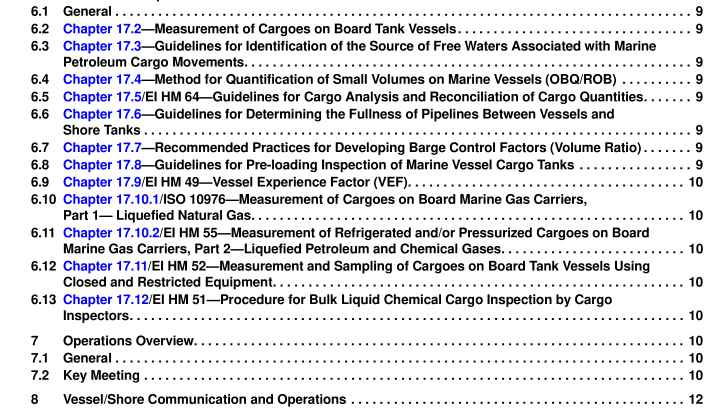API MPMS 17.1:2014 pdf free download.Manual of Petroleum Measurement Standards Chapter 17.1 Guidelines for Marine Inspection
4 Safety and Health Considerations
4.1 General Personnel involved with the gauging and sampling of petroleum and petroleum-related substances should be familiar with their physical and chemical characteristics, including potential for fire, explosion, and reactivity, and with the appropriate emergency procedures as well as potential toxicity and health hazards. Personnel should comply with the individual company safe operating practices and with local, state, federal, and national regulations, including the use of proper protective clothing and equipment. Personnel involved in inspection, measurement, and/or sampling on board a vessel shall at all times be accompanied by a designated ship’s representative.
4.2 Static Electricity Hazards If the tank is in a non-inert condition, specific precautions will be required with regard to safe measurement and sampling procedures when handling static accumulator oils. These are generally as follows; during loading, and for 30 minutes after the completion of loading, metallic equipment for dipping (gauging), ullaging, or sampling shall not be introduced into or remain in the tank.
Examples of equipment include manual steel ullage tapes, portable gauging devices mounted on deck stand pipes, metal sampling apparatus, and metal sounding rods. Nonconducting equipment with no metal parts may, in general, be used at any time. However, ropes or tapes used to lower equipment into tanks shall not be made from synthetic materials. After the 30-minute waiting period, metallic equipment may also be used for dipping (gauging), ullaging, and sampling, but it is essential that it is effectively bonded and properly grounded before it is introduced into the tank and that it remains grounded until after it has been removed.
Operations carried out through stand pipes are permissible at any time because it is not possible for any significant charge to accumulate on the surface of the liquid within a correctly designed and installed stand pipe. A stand pipe should extend the full depth of the tank and be effectively bonded and earthed to the tank structure.
4.3 Health Hazards Petroleum vapor dilutes oxygen in the air and may also be toxic. Hydrogen sulfide (H 2 S) vapors are particularly hazardous. Petroleum vapors with relatively low concentrations of hydrogen sulfide may cause unconsciousness or death.
During and after the opening of any tank or vapor control valve, personnel should position themselves to avoid any gas which may be released. Harmful vapors or oxygen deficiency cannot always be detected by smell, visual inspection, or judgment. Appropriate precautions should be used for the protection against toxic vapors or oxygen deficiency. It is recommended that users always wear gas monitors that, as a minimum, measure gas concentrations of H 2 S.
Procedures should be developed to provide for the following:
a) exposure monitoring,
b) need for personal protective equipment, and
c) emergency rescue precautions.
When necessary, suitable fresh air breathing equipment should be worn prior to entering the gauge site and during the gauging and sampling procedure.
This discussion on safety issues is not exhaustive and the appropriate API or Energy Institute publications, together with the International Safety Guide for Oil Tankers and Terminals (ISGOTT) [3] , Safety of Life at Sea (SOLAS) [5] , and Oil Companies International Marine Forum (OCIMF) [4] publications should be consulted for applicable safety precautions.
5 General Information Gauging may be performed manually or by automatic systems in accordance with procedures appropriate to the type of vessel, cargo, and location (see API MPMS Ch. 3.1 A, Ch. 3.1B, Ch. 3.4, Ch. 3.5, Ch. 1 7.2, Ch. 1 7.1 0.1, Ch. 17.1 0.2, Ch. 17.11 , and Ch. 17.1 2).
All responsible parties should be informed if any of the gauging equipment or tank or meter facilities have a known bias. Documentation of these deviations should be available for inspection by all responsible parties and should be used in preparing volume reconciliation. Possibilities for known bias error includes but are not limited to water, snow, ice, or debris on floating-roof tanks.
The procedures described in this publication should be performed by properly trained personnel. If the procedures cannot be performed for any reason (such as safety, environmental, or physical constraints; governmental restrictions; conflicts with contractual agreements; or other problems), the inspection report should include a complete, detailed explanation.
Measurement personnel are responsible for ensuring the use of proper safety, measurement, and sampling equipment. The vessel’s master and/or designated representative, the shore supervisory personnel, and the measurement personnel conducting the inspection should be familiar with the scope of the cargo inspection procedures and aware of the safety procedures unique to the product being transferred.API MPMS 17.1 pdf download.API MPMS 17.1:2014 pdf free download
